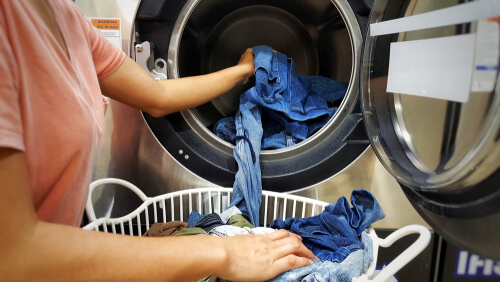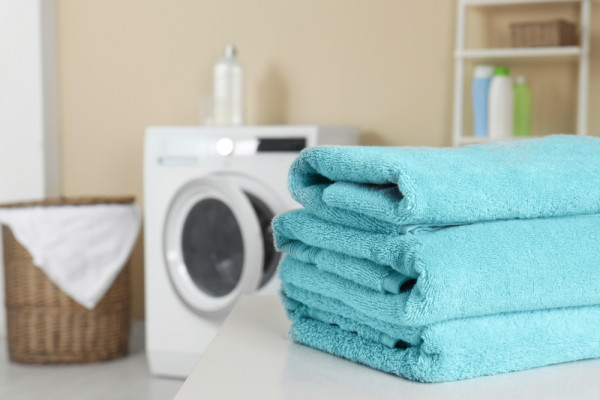Tumble dryers come in various shapes and sizes. They come with different features too. So shopping for a new one can get complicated.
To help you choose the right appliance for your home, we’ve put together this handy guide — covering some of the most common questions people ask about tumble dryers.
And if you’re wondering what all the symbols mean, we’ve got a whole separate post about that.
Prefer to watch?
What’s the difference between the main types of tumble dryer?
A dryer is a dryer, right?
Well, it’s not usually that simple. Let’s take a look at the three main types of tumble dryer — heat pump, condenser and vented. (You can also get combination washer-dryers, which do the job of both washing and drying. These are ideal when space is limited.)
Heat pump dryers
With heat pump dryers, hot air is pushed through the drum, which carries moisture to the dryer’s reservoir. It keeps pushing hot air through until the clothes are dry.
Condenser dryers
Condenser tumble dryers work a bit like heat pump dryers — except there are two different airflows. Air is circulated inside the dryer, which heats it up and draws moisture from the clothes. As this damp air is flowing one way, the air from the room is passed through a condenser. The condenser turns the moisture vapour into water. This water is then pumped out through a hose or tank.
Vented dryers
Vented tumble dryers simply draw the moisture out of your laundry and get rid of it through a hose or vent. There’s no conversion or compression of the vapour.
What capacity is right for you?
Think about how much laundry you need to dry, and how often. And don’t forget to consider the size of the items you want to dry too.
As a rule, tumble dryers come in small, medium and large:
- Small — dries up to 17 hand towels in a single drying cycle
- Medium (7kg capacity) — dries up to 20 hand towels in a single cycle
- Medium (8kg capacity) — dries up to 22 hand towels in a single cycle
- Large — dries up to 25 hand towels in a cycle and is ideal for drying large items like duvets
Are tumble dryers expensive to run?
Tumble dryers used to have a reputation for being one of the most energy intensive appliances in the home. But in recent years, some big improvements have been made when it comes to dryer efficiency.
Appliances range from A+++ (most efficient) down to D (least efficient), with most condenser dryers around B or C. Some heat pump dryers are now being given A+ ratings, but vented dryers don’t tend to achieve this kind of efficiency.
Overall, condenser dryers are generally the least expensive to run.
A note on smart sensors
Sensor dryers can cut your energy use in half. They sense when the moisture has been removed from your clothes and automatically stop — instead of wasting electricity and needlessly finishing the cycle. Lots of these appliances let you choose your preferred level of dryness, ranging from cupboard dry (dry enough to store or wear straight away) to iron dry, which leaves clothes slightly damp.
What about features?
It’s worth looking for a dryer with large-capacity automatic dispensers. Some can hold up to a month’s worth of fabric softener, saving you time and hassle. Also, consider which loading style best suits your needs.
Front-load dryers are the most popular. They offer optimal drying efficiency, maximum capacity, excellent cycle variety, a wide range of features and are often the best value.
Stacked washer dryers, combo washer-dryer units and compact portable dryers are great if you’re short on space — but with these styles, you won’t get as many features or cycle options.
To get the best range of functions, stick to a standard style and look out for:
- Steam setting — perfect for freshening up clothes and getting rid of wrinkles
- Quiet mode — minimises noise (which is a huge advantage in open-plan homes)
- Stainless steel interior — looks slick and stops the drum from going rusty
- Multiple spin speeds — adjust as needed, according to fabric type
- Air fluff/low heat mode — protects materials that are sensitive to heat
Where should a tumble dryer go?
Compared to other white goods, a tumble dryer needs more space around it. It’s important that air can circulate freely. And when it comes to heat pump and condenser dryers, they need to get rid of air and moisture vapour.
Is it okay to put a condenser dryer in a cupboard?
The short answer is no.
Heat pump dryers need around 2 to 3 square metres of space (depending on the manufacturer’s instructions). Without proper clearance, the air will just make the dryer warmer — which pushes it to work harder and less efficiently. So no, putting a condenser dryer in a cupboard isn’t a good idea.
What’s the smallest tumble dryer?
If you’re stuck for space, there are options available.
The smallest tumble dryers can actually be considered ‘desktop’ models, which are able to dry very small loads — roughly two days’ worth of washing for one person. You can also get other versions of compact dryers that don’t take up too much room in smaller homes.
Our blog is loaded with more related articles

Tumble dryer tips
Cost of running a tumble dryer
In the rainy UK, we can’t hang laundry outside for much of the year. So perhaps you’re looking at tumble dryers and...
Read more

Tumble dryer tips
Is it safe to tumble dry jeans?
Before turning on the dryer, you might want to check if you can actually tumble dry your jeans or bed sheets. Here’s our...
Read more

Tumble dryer tips
How to dry your clothes indoors in winter
Find out how to use your tumble dryer more efficiently over the winter, alongside some alternative ways you can dry your clothe...
Read more
